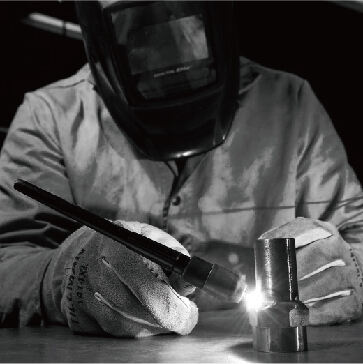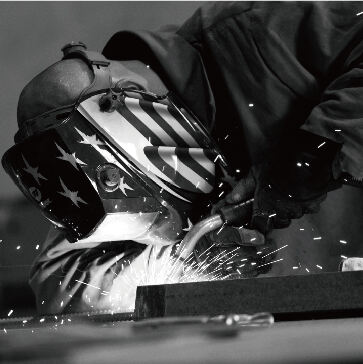Welding is the process of combining the materials of the workpieces by applying heat or pressure or both, with or without filler material, to achieve a permanent connection by atomic bonding. Arc-based welding is called arc welding. The most common types of arc welding are stick welding (MMA), MIG/MAG welding (GMAW) and TIG welding (GTAW).
In this article, we will introduce what MIG welding is, how it is different from TIG and MMA welding, and some of the advantages and disadvantages of MIG welding.
What is MIG Welding and how does it work?
In MIG/MAG welding, the arc melts the welding wire and the parent material to form a molten pool and the weld area, which is protected by an inert gas or an active gas, which can effectively prevent the harmful effects of the surrounding air.
MAG welding (Metal Active Gas Welding) uses an active gas such as carbon dioxide (CO2) or a mixture of CO2 and argon as a shielding gas. These reactive gases can interact with the weld pool, affecting the chemical composition and mechanical properties of the weld. Commonly used for ferrous metals such as mild steel and stainless stee.
MIG welding (Metal Inert Gas Welding) uses an inert gas (usually argon or helium) to protect the weld pool from atmospheric pollutants. The process is particularly effective for welding non-ferrous metals such as aluminum and copper.

What is the difference between MIG and TIG Welding?
The most obvious difference between MIG and TIG welding is the use of electrodes.
The MIG welding process uses a continuously fed consumable wire electrode to join two pieces of metal. TIG uses a non-consumable tungsten electrode and a separate filler metal. While you can do MIG welding with just one hand, TIG welding requires you to hold the TIG welding gun in one hand and the filler material in the other. Holding a filler stick can sometimes be cumbersome for welders, but it provides greater control because you can precisely apply the filler material along the arc.
MIG welding is generally considered easier to learn, easier to operate, faster, and better for welding thicker materials. However, TIG welding is more controlled, more precise, better for welding thinner materials, and produces neater welds with little to no finishing required.

What is the difference between MIG and MMA Welding?
While MIG uses a continuous wire electrode and relies on a shielding gas, MMA welders do not require a shielding gas because the electrode itself provides a protective coating that melts and covers the weld puddle.
MMA welding is often used to weld thicker materials, such as steel or cast iron, because it produces strong, durable welds that can withstand high stress and strain. It can also be used to weld outdoors or in windy conditions because the electrode coating provides some protection from wind and weather.
MMA welding is more difficult to master than MIG welding because it requires a steady hand and good control of the welding arc. The operator must also be careful to maintain the correct electrode angle and keep a consistent distance between the electrode and the workpiece.

Advantages of MIG Welding
1.Easy to use
MIG welding is relatively easy to learn and operate, and beginners can easily master it, and experienced welders can also operate it efficiently.
2.High productivity
MIG welding can save time and improve productivity because there is no need to frequently change welding rods or remove welding slag.
3.Versatility
MIG welding is extremely versatile and can weld a variety of metals and alloys, such as aluminum, copper, stainless steel, mild steel, etc., suitable for DIY, home welding, automotive repair and industrial applications.
4.Clean welds
Compared with other processes such as SMAW (stick welding), MIG welding generally produces cleaner welds with minimal spatter and slag, reducing the need for post-weld cleaning.
5.Excellent welding results
MIG provides better visibility of the weld pool. Coupled with the simplicity of the process and the better control provided by automatic wire feeding, MIG can easily produce good welding results.
6.All-position welding capabilities
MIG welding can be performed in any position (such as flat welding, vertical welding, horizontal welding and overhead welding), which makes it very flexible in a variety of application scenarios.
Disadvantages of MIG Welding
1. Although MIG is cleaner than most welding processes, MIG cannot beat TIG for "aesthetic quality" projects involving thin sheet metal
2. The initial cost will be high. Using a MIG welder is not as cheap as using a stick welder. The good news is that your MIG welder will last for many years.
3. Not suitable for outdoor use. Any wind or breeze will blow away the shielding gas, exposing the weld to contaminants. In addition, the need for a shielding gas supply means that it is not an easy task to move the welder frequently.
MIG Welder Frequently Asked Questions
1.Is MIG welding good for beginners?
Yes, MIG welding is often recommended for beginners due to its ease of use, versatility, and efficiency. Most MIG welders come with adjustable voltage and wire feed speed settings, allowing beginners to fine-tune the machine to fit their specific needs and improve their welding skills.
2.Is a MIG welder worth it?
Yes, a MIG welder is worthwhile for many users, it can weld a variety of metals including steel, stainless steel and aluminum, and is suitable for beginners and experienced welders. Its faster process and less post-weld cleanup make it ideal for DIY, home projects, automotive repair and industry.
3.Can I weld aluminum with a MIG welder?
Yes, you can weld aluminum with a MIG welder, but it requires some specific considerations:
Proper Equipment: Use a welder with a spool gun or a push-pull system to feed the softer aluminum wire.
Shielding Gas: Argon gas is typically used for aluminum welding.
Settings: Adjust the settings for higher heat input as aluminum requires more heat than steel.
4.What Can I Weld With A MIG Welder?
MIG welding can be used on various metals or metal alloy, including steel, stainless steel, carbon steel,magnesium,nickel,copper and aluminum.
5.Can I MIG weld without gas?
Yes, you can using a process called flux-cored arc welding (FCAW). While it is convenient for outdoor and windy conditions, it tends to produce more slag and spatter than gas-shielded MIG welding.

 EN
EN
 AR
AR
 BG
BG
 HR
HR
 CS
CS
 DA
DA
 NL
NL
 FI
FI
 FR
FR
 DE
DE
 EL
EL
 HI
HI
 IT
IT
 JA
JA
 KO
KO
 NO
NO
 PL
PL
 PT
PT
 RO
RO
 RU
RU
 ES
ES
 SV
SV
 TL
TL
 IW
IW
 ID
ID
 LV
LV
 LT
LT
 SR
SR
 SK
SK
 SL
SL
 UK
UK
 VI
VI
 HU
HU
 TH
TH
 TR
TR
 MS
MS
 BE
BE
 KK
KK
 KY
KY

